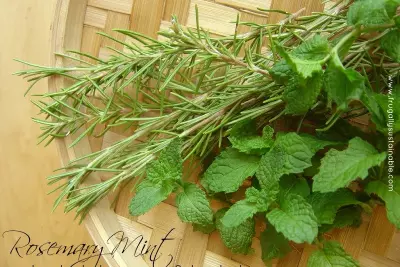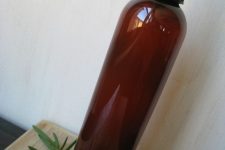Dry Scalp.
Dandruff.
Restore luster.
Shine.
Nourish.
This shampoo bar was created to heal the scalp and is perfect for darker hair colors!
…as quoted by Natural News, “will help to combat dandruff, and [when] applied to the hair will make hair gloriously glossy (especially dark hair). Combined with horsetail, rosemary is said to aid hair loss recovery in cases where hair loss has been due to stress and worry.”
Horsetail…
…is super high in the mineral silica (the essential element in the production of collagen) — which is known to help strengthen weak, dry, brittle or damaged hair — and when applied to lifeless hair…shine, smoothness and vitality are what remain. Also high in minerals such as potassium, selenium and manganese — horsetail prevents hair loss, promotes hair growth, and contributes flexibility and strength to the hair.
…of rosemary and peppermint are an invigorating combination! Together, they help with a multitude of hair and scalp conditions such as dandruff. They also stimulate hair growth and restore shine to lackluster hair.
Rosemary Mint Shampoo & Body Bar Recipe
Ingredients
Oils
- 8 ounces coconut oil
- 8 ounces olive oil
- 8 ounces organic, sustainably-sourced palm oil
- 4 ounces shea butter
- 2 ounces cocoa butter
- 3 ounces castor oil
Liquid
- 10 fluid ounces water or a handmade rosemary and peppermint water infusion, click here to learn how to make an herbal water infusion
- 4.52 ounces lye (7% excess fat)
Add-Ins
- 1 teaspoon rosemary powder
- 1 teaspoon peppermint leaf powder
- 1 teaspoon horsetail powder
- 2 ounces jojoba oil
- 1-2 ounces essential oil blend of rosemary and peppermint
Soap-Making Basics
Thanks to the Internet and amazing people who are willing to share their wisdom so freely…I was able to learn the skill. I primarily use the hot processed method…however, choose the method you feel most comfortable with:
- Wardeh, who runs Gnowfglins, on her personal blog Such Treasures gives the clearest, most easy to follow directions ever! This is the exact post that got me started. She uses the hot processed method and I highly recommend that you read her recipe if you are even the slightest bit interested in making your own soap.
- Renee of Fimby was also very inspirational and such a great resource! Watch her awesome video that describes the cold processed method for making a simple soap by clicking here.
If you are new to soap-making, I strongly suggest you read through these very informative articles and find what will work for you:
I would also recommend borrowing a few of these books from the library if you really find yourself wanting to know more:
- Handcrafted Soap by Dolores Boone
- The Soapmaker’s Companionby Susan Miller Cavitch
- The Natural Soap Book by Susan Miller Cavitch
Hot Process Method
*Remember…there are 2 different methods for soap-making — hot and cold process — this is the Hot Process Method.
- Measure both the lye and water (or herbal infusion it using) – each in separate bowls — using a kitchen scale. Note: Always run your recipe through a lye calculator to be sure that you are using the proper amount of oils, lye, and liquid.
- Carefully combine the lye and liquid by pouring the lye into the liquid (never pour liquid into the lye) and stir liquid until lye is completely dissolved. The liquid is caustic and not to be touched in any way. The outside of the bowl will be extremely hot as well. Be careful when working with lye and follow all of the recommended precautions. Note: What I’m trying to say is, I can not be held responsible for any craziness, mishaps, explosions, etc. that may happen when making this recipe.
- Allow the lye mixture to stay under a vent and cool down while you prepare the oils.
- Measure the oils – by weight – and then place in a crock pot to melt on low heat. Please omit the essential oils and jojoba oil…we will be adding them later.
- Once melted, add the lye/water mixture to the oils in the crock pot and stir. Note: Any equipment the lye touches needs to be neutralized in a mixture of white vinegar, soap, and water.
- After a brief stir, grab your stick blender and get to work! Blend the oils and liquid in the crock pot for at least 1-2 minutes. We are working toward “trace.”
- After 1-2 minutes, add the herbal powders. Using a wire whisk, whisk until well combined.
- Continue whisking for 2-3 minutes more – until the mixture becomes a thick, pudding like consistency.
- Once the mixture is pudding-like, cover the crock pot and “cook” the soap, on low heat, for approximately 1 hour.
- Prepare your mold. Note: I just use a standard loaf pan lined with parchment paper and it’s always worked perfectly and this recipe is enough to fill one loaf pan.
- Once the soap is done “cooking” remove from heat and quickly add the essential oils and jojoba oil.
- Stir until well combined.
- Spoon soap mixture into mold.
- Allow soap to cool and harden for 24 hours.
- Remove from mold on to cutting board and cut into bars.
- Place bars on a tray with good airflow so that they can harden further.
Where Can I Get This Stuff
–Starwest Botanicals… they have everything you’ll need by way of Bulk Herbs, Organic Oils & Butters, and Natural Products for Healthy, Natural Living! It’s your one-stop-shop!
–Mountain Rose Herbs & The Bulk Herb Store also carries many of these ingredients if you’d like to price check.
-I also just love the people over at The Soap Dish. You can purchase lye and other ingredients necessary for this recipe.
-For the ultimate all-natural healthcare alternatives choose high quality essential oils.





 In the Garden :: Growing Food in the Desert
In the Garden :: Growing Food in the Desert
Can you make this same recipe as a cold process soap, or would something need to be changed to convert from hot to cold? I have always made cold process soaps because that is how I originally learned, so I would prefer that method if possible 🙂
Hi there JenZ…you could absolutely use the same recipe with the cold process method!
Love this hair & body bar. Will probably never use any thing else. Love your products!
So AWESOME Sharlene! Thank you for your kind words 🙂
I just want to say thanks so much for all the work you put into this site. I made soap for the first time 2 weeks ago. (using one of your recipes) and it turned out great. It took me almost a year to get up the nerve to try it. I have learned so much from you. Thanks again. Have a Blessed day. Char
I agree with Char. It took me almost a year to get up the nerve to make soap, but with Andrea’s recipes I did it! I LOVE making soap. It’s my favorite past time. I also made her Herb tinted lip balm a couple days ago and it was heavenly. SO many incredible recipes. Andrea, you are so generous for sharing.
THANK YOU!
Thank YOU E. Stone! I just love reading all of these stories of new soap-makers 🙂 And yes…that tinted lip balm is the best isn’t it! It’s great for gifts for the coming holiday season (or gifts anytime really). Thank you also for your kind words of encouragement. They mean so much!
Char!!! Wow! That’s sooooo awesome! You just gave me chills of excitement reading your comment! Your words have blessed me today and I’m so proud of you for taking one more step closer to sustainability! Isn’t soap-making just great 🙂
I just skimmed quickly the article here just want to add a caveat and a suggestion with a grain of salt…. alot of the volitile herby goodness will be cooked of so to speak with the heat of making soap so if added after trace you have a better chance of retaining the great properties…
Also when I make shampoo bars I add a much higher percentage of castor oil for the bubble / feel factor it adds… it does increase the time for curing to a firm bar in cold process but creates a more satisfying product IMHO.Especially for those new to shampoo bars.
Whalesongsoap….. my former company since retired sally rawlings
Hi Sally,
How much more castor oil do you use? I have read that it is great for hair.
How do you use the bar when you wash your hair? (I’m new to shampoo bars)
What other oil can be used for the palm oil?
Beef tallow has the same SAP value (my personal preference, too). Lard is a close second in SAP value. If you are opposed to animal fats, hemp seed oil is a close third. I tend to substitute a bit of the other fluid oils with a bit of hemp seed oil for its excellent properties. Run through a lye calculator to verify herbal infusion (or water) and lye amounts when altering your recipe.
Okay, thanks. I will try lard because I can find it easily. I will ask the meat market for some beef fat so I can render it. Also, how big is your crock pot. I want to make sure it doesn’t over flow. Can’t wait to make it.
I need a conditioner for my hair, it is so long that to fasten my bra I have to pull it over my shoulder otherwise it gets tangled in the little hookie things.
Do you have any kind of natural conditioner that would de-tangle long hair?
I noticed the Rosemary mint vinegar rinse it says “it is an excellent hair cleanser and stimulates hair growth. Likewise, peppermint aids against thinning of the hair.” I was wondering if this bar soap does the same thing. I love these two scents but I have thin, oily hair; I was wondering if this soap would be a good option for me?